Vote! Today!
You can always vote with your fork. Today is the day to vote with your vote!


You can always vote with your fork. Today is the day to vote with your vote!

The World Health Organization’s Europe branch has issued a brave new report: Tackling food marketing to children in a digital world: trans-disciplinary perspectives (2016)

I say brave because marketing to children is the food industry’s line in the sand.
Food and beverage companies will not stop marketing to children because doing so will hurt their bottom lines too much.
WHO Europe makes eight recommendations, all of them highly political:
1. Acknowledge States’ duty to protect children online with statutory regulation
2. Extend offline protections online
3. Define legal age, rather than leaving commercial interests to do so
4. Define marketing directed to children
5. Draw on existing legislation, regulation and regulatory agencies
6. Compel private Internet platforms to remove marketing of foods high in saturated fat, salt and/ or free sugars
7. Develop appropriate sanction and penalty mechanisms
8. Devise cross-border international responses
The report’s conclusion:
Children’s participation in digital media should not, however, be predicated on receiving digital HFSS [high in saturated fats, salt and/or free sugars] advertising. Digital marketing can amplify the power of earlier marketing practices by identifying and targeting more vulnerable populations with sophisticated analytics and creating engaging, emotion-focused, entertaining ways to reach children.
Nor should children’s digital participation be predicated on “devolving” consent to parents, which is akin to States expecting parents to completely prohibit their children from watching all television in order to avoid HFSS marketing, rather than implementing broadcast regulations.
Instead, States and supra-national actors should devise ways to allow children to participate in the digital world without being targeted by marketers with immersive, engaging, entertaining marketing of products that have been demonstrated to be injurious to their health.
Now if governments would just listen….
The Rudd Center for Food Policy & Obesity at the Univeristy of Connecticut produces terrific reports. The latest is Baby Food FACTS: Nutrition and marketing of baby and toddler foods and drinks:
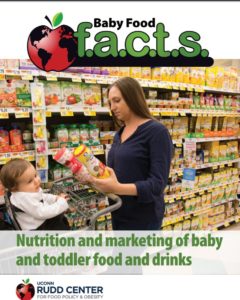
Infant formula companies have a marketing problem: breast milk is a better option, all formulas have the same nutrient composition by FDA regulation, and babies only need to use formula for a few months.
Baby food companies also have a marketing problem: babies can eat table foods (suitably ground or cut) and don’t really need the stuff in jars (convenient thought they may be).
The Rudd Center report takes a good hard look at the
The findings: The nutritional quality is pretty much as advertised but nearly 60 percent of advertising dollars go for products that are not recommended for young children such as sugar-sweetened toddler milk, nutritionally poor snack food, and Pediasure, a high-calorie liquid nutrition supplement.
Here’s the full report
And here’s a summary
This year, only three Senators—Bernie Sanders, Kirsten Gillibrand, and Richard Durbin—got top scores from Food Policy Action for their votes on food and farm issues. This is down from the 29 who earned perfect scores in 2015.
In the House, 79 representatives got perfect scores as opposed to 87 in 2015.
The annual Scorecard ranks lawmakers on whether they support legislation on issues such as GMO labeling, hunger, fisheries management, food waste, pesticides, the EPA’s waters of the U.S. rule, among others.

It’s disappointing that fewer legislators are getting top scores, since one of the purposes of this activity is to hold them accountable and encourage more liberal voting on food and farm issues.
As decriminalization of marijuana use proceeds steadily, I am seeing more attention focused on cannabis-infused edibles. These are now produced commercially by businesses that go well beyond brownies.
Pediatricians, as I’ve discussed previously, are worried about kids eating them.
These days:
But in Colorado, where such things are legal, producers are complaining that the regulatory environment is so difficult that they can’t make a profit.
According to a report in the industry newsletter, Bakery and Snacks, the profit problem was the focus of an education session at a Las Vegas conference on “The Future of Wholesale Baking with Marijuana,” conducted by two producers of infused edibles, Sweet Grass Kitchen and Love’s Oven. Their gripes:
Startups are always hard. But with half of $27 billion at stake, and more and more states considering legalizing the stuff, I can see why they are hanging in there.
While we are on the topic, a new paper in JAMA reviews statistics on marijuana use in the U.S. and reports 7000 new users a day, and rising. It calls for better surveillance of how much is used, and how.
I will be watching the use and the business of edibles with much interest.
Over the weekend, the New York Times ran a front-page story titled “Doubts About the Promised Bounty of Genetically Modified Crops.”
The controversy over genetically modified crops has long focused on largely unsubstantiated fears that they are unsafe to eat.
But an extensive examination by The New York Times indicates that the debate has missed a more basic problem — genetic modification in the United States and Canada has not accelerated increases in crop yields or led to an overall reduction in the use of chemical pesticides.
The Times illustrated the article with some interesting graphics.
This one shows European yields of non-GMO sugar beets increasing far more rapidly than those of GMO beets in the U.S.
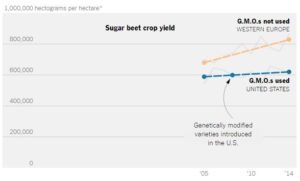
Others compare use of chemical pesticides, first in France, where pesticide use is falling rapidly.
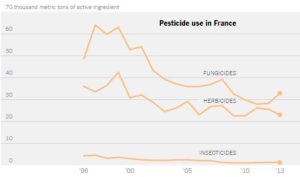
Then in the U.S. where insecticide and fungicide use is down a bit, but herbicide use is rising and will continue to rise as GMO crops become increasingly resistant to Roundup (glyphosate) herbicides.
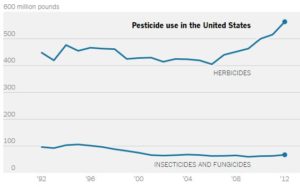
The agbiotech industry has long maintained that genetic modification would increase yields and decrease pesticide use. After 20 years, that hasn’t happened.
I wrote about all this in 2003 in my book Safe Food: The Politics of Food Safety. Half the book is about GMOs and its arguments hold up pretty well.
I said then and still maintain that until this industry fulfills its promises—and produces GMO crops sustainably—it will continue to have big problems with consumer acceptance.
The Times says this is the first article in an occasional series. I look forward to seeing the next.
Aren’t you happy that it’s that sweet, gooey time of year again?

As Julia Belluz of Vox points out
Candy and Halloween didn’t always go hand in hand. It wasn’t until the 1950s that that candy industry started to push the stuff as a way to boost flagging fall sales.
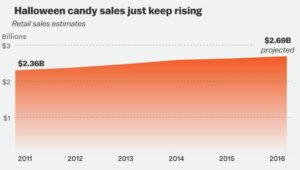
The candy industry would love you to think:
Kids do love candy, as this marketing report tells us. I’ll bet these favorites have everything to do with advertising budgets.
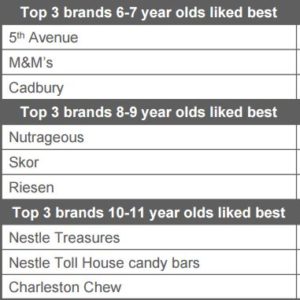
Does candy have a place in healthy diets? Sure, but in very small and occasional amounts.
Good luck getting through tonight’s trick-or-treat.
Happy Halloween, everyone.
Joy Santlofer. Food City: Four Centuries of Food-Making in New York. WW Norton, 2016 (publication date: November 1)

I wrote the Foreword to this book:
When Jonathan Santlofer asked me to write a few words of introduction to Food City, written by his late wife, Joy, I felt sad but honored. Joy, my friend and colleague at New York University, died unexpectedly in 2013, leaving this book—her life’s work—to be completed posthumously by grieving family and friends.
Food City is a tribute to the memory of a wonderful person, but it is also a very good book, standing easily on its own as a welcome contribution to food history and to the field of food studies. In her work at NYU, first as a master’s student and later on our faculty, Joy discovered evidence of New York City’s food manufacturing past and began writing about this largely unexplored topic. She published her discoveries as short pieces that formed the basis of this book and also of her work as editor of the journal of the Culinary Historians of New York.
For those of us who use food to explore the most pressing social, environmental, and political issues through the lens of food—how we at NYU define food studies—Food City is exemplary. In recounting the stories of the rise and fall of New York City’s bakeries, breweries, dairies, and meat-packing plants, and of its makers and sellers of flour, sugar, pasta, ice cream, chewing gum, and soda water, Joy Santlofer necessarily wrote about slavery, immigration, unions, child labor, wars, ethnic and racial discrimination and segregation, and the migration of populations to the suburbs and their eventual return. How odd, she said, to think that factories spewing filth once occupied the sites of today’s luxury apartments.
Food City’s theme is the historical arc from artisanal food manufacture to the emergence and eventual disappearance of industrial manufacture to today’s newly artisanal production of beer, chocolate, and coffee.
Joy put her scholarly curiosity to good use. She had a knack for finding just the right detail to bring history to life. I had no idea that New York City housed 2,000 bakeries by 1900, or that one of them employed 700 horses to deliver bread door to door, nor did I know that through the 1930s, $14 a week was the standard wage for factory workers, a synagogue on Rivington Street was located over a still, and cattle had to be driven across the entire length of 44th Street to be slaughtered. Such tidbits are so vivid that you even get a sense of what the City must have smelled like until well into the last century.
For several years, Joy had the office next to mine, and I was able to check with her often on the book’s progress. I couldn’t wait for it to appear and at last we have it. It’s heartbreaking that she did not live to see its publication, but Joy Santlofer leaves Food City as a generous gift to us all.
–Marion Nestle, May 2016